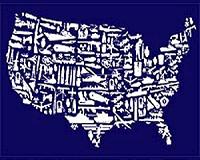| . |  |
. |
San Jose, Calif. (UPI) Jun 1, 2010 A suspected terrorist raid on an Indian train that killed 76 people points to a trend that can confront governments worldwide with a security risk of major proportions, anti-terrorist expert Brian Michael Jenkins said. Jenkins' comments followed security experts' reports that security of hundreds of miles of rail, if threatened, would be one of the hardest operations to contain and control. India has the world's fourth largest rail network, after the United States, Russia and China but reputedly is the largest handler of railroad people traffic in the world. Train traffic in India averages 14,000 journeys per day. Indian police said Maoist rebels were responsible for a train collision May 28, caused when a speeding freight train rammed into an express passenger train from Kolkata to Mumbai minutes after it derailed. Police said the derailment occurred because a part of the track was removed. Several carriages crammed with passengers were hit by the cargo train traveling on an adjacent line. Maoist rebels have frequently attacked trains in India and warned of further violence before the latest attack. The train derailment could have serious implications for other countries, said Jenkins, director of National Transportation Security Center of Excellence at Mineta Transportation Institute in San Jose, Calif., established and funded by the U.S. Congress. He said the Indian raid raised the risk of copycat actions. Terrorists make note of methods, taking lessons from all attempts, whether successful or not, and these lessons can be applied to other systems, he said. "The death toll between 2000 and 2010 is 13 times greater than that in the 1990s, although, owing to two bloody incidents, it is only slightly greater than the 1980s," said Jenkins, who was invited to India earlier to advise on railroad security. The latest outrage meant that transportation security and counter-terrorism experts must take their own lessons so they can create safer and more secure systems in their countries, he said. "The threat seems to be growing, with at least 30 deliberate derailments in India since January 2000, almost four times the number of derailments in the 1990s and 15 times the number of incidents in the 1980s," said Jenkins. MTI will be examining this case and other recent attacks in India to see what lessons might be learned and how these may be applied to other countries. MTI's database of attacks on surface transportation showed the Indian attack May 28 was India's worst terrorist raid on passenger rail since 2006, and its bloodiest deliberate derailment in decades. On July 11, 2006, terrorists detonated seven bombs on Mumbai's crowded commuter trains, killing 207 people and injuring hundreds of others. The last comparable derailment occurred in 1989, when sabotage derailed the Bangalore-Delhi Express killing 67. An MTI report on deliberate derailments, "Off the Rails: The 1995 Attempted Derailing of the French TGV (High Speed Train) and Quantitative Analysis of 181 Rail Sabotage Attempts," showed India's rail system suffering the most terrorist derailments with 42 incidents or 23 percent of the total number of such incidents. India has also suffered the largest number of terrorist bomb attacks against train and bus targets with 387 incidents since 1970, or 17 percent of the total, the report showed. Jenkins will return to India later in 2010 to explore security collaboration between U.S. experts and Indian counterparts.
Share This Article With Planet Earth
Related Links The Long War - Doctrine and Application
 U.S. security focus on international help
U.S. security focus on international helpWashington (UPI) May 27, 2010 The United States must strengthen international partnerships and rebuild its own economy to create a strong national security, President Barack Obama said in his first national security plan, which was released Thursday. The strategy strongly emphasizes looking beyond military might to diplomatic tools and international collaboration to achieve U.S. security objectives. "Our arme ... read more |
|
| The content herein, unless otherwise known to be public domain, are Copyright 1995-2010 - SpaceDaily. AFP and UPI Wire Stories are copyright Agence France-Presse and United Press International. ESA Portal Reports are copyright European Space Agency. All NASA sourced material is public domain. Additional copyrights may apply in whole or part to other bona fide parties. Advertising does not imply endorsement,agreement or approval of any opinions, statements or information provided by SpaceDaily on any Web page published or hosted by SpaceDaily. Privacy Statement |